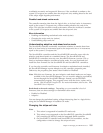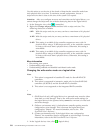to the source drive after you create a FlashCopy backup are not reflected on the
target drive. You can use the backup copy of data for tape backup, drive cloning,
and multi-server rollout.
There are two primary FlashCopy functions: backup and nobackup. The FlashCopy
backup function copies the entire contents of the source drive to the target drive so
that entire logical drives can be moved from one server to another. The FlashCopy
nobackup function creates a temporary copy of a drive for tape drive backup and
reference purposes. The FlashCopy nobackup function is less I/O-intensive than
the FlashCopy backup function.
Before using FlashCopy, consider the following requirements:
v You can perform a FlashCopy backup operation on only one controller at a time.
v The source and target logical drives can have the same or different RAID level
(they do not have to match).
v The source and target logical drives must be on the same controller.
v You can create a maximum of four independent FlashCopy backups per
controller.
v There is no limit on the size of the source and target logical drive. However, for
both FlashCopy backup and nobackup operations, the size of the target drive
must be greater than or equal to the source drive.
v You cannot perform any action on a FlashCopy source or target logical drive
(such as synchronizing the drive). You can only delete a FlashCopy backup.
More information
v Creating a FlashCopy backup
v Removing a FlashCopy backup
Understanding
copy back mode:
Note: Copy back is supported on the ServeRAID-8i, ServeRAID-7k,
ServeRAID-6M, and ServeRAID-6i/6i+ controllers only. It is not supported
in cluster or failover pair configurations.
Copy back is a method of restoring a logical drive’s original configuration after
you replace a failed drive in an array. It allows you to restore the data to its prior
location, before the logical drive was rebuilt from its spare.
An example
A RAID Level-5 logical drive consists of three physical drives and a spare. When a
drive in the array fails, the spare drive is used to rebuild the logical drive. When
you replace the failed drive, copy back moves the data from the former spare to
the newly replaced drive. Then, the former spare resumes its original role as the
spare drive.
Copy back is enabled by default; it starts automatically when the ServeRAID
controller detects that a failed drive is replaced. The ServeRAID Manager displays
a progress indicator in the status bar while the operation is in progress. To disable
copy back, choose Disable copy back mode from the controller object Action menu.
You cannot perform any other actions on the controller until copy back is
completed.
198 ServeRAID Manager Installation and User's Guide


















